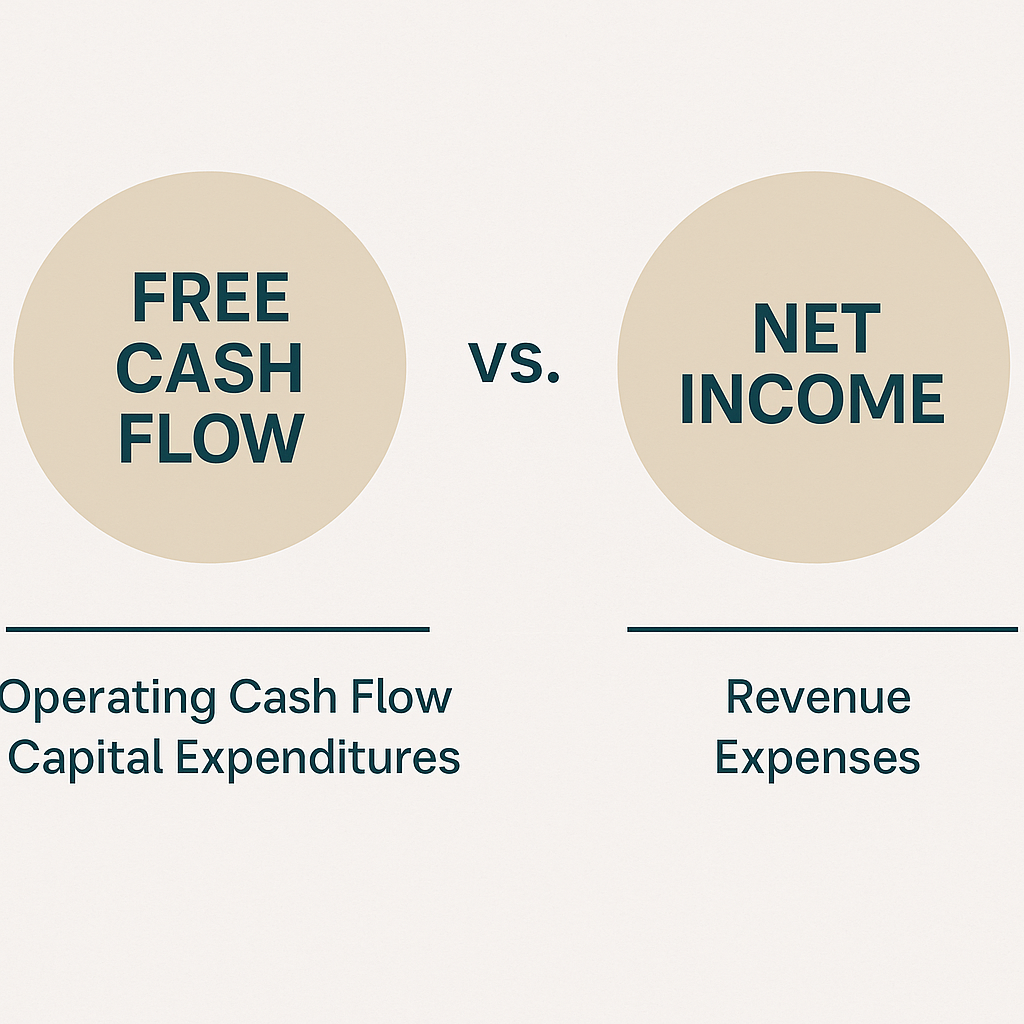Introduction
Free Cash Flow vs. Net Income: What’s More Important? When it comes to evaluating a company’s financial health, two terms get thrown around a lot: Net Income and Free Cash Flow (FCF). On paper, both look like bottom-line numbers, but in reality, they can tell vastly different stories. One is often used in income statements, and the other plays a starring role in investment decisions. But which one actually matters more? Let’s unpack this in a way that makes sense, even if you’re not an accountant.
Table of Contents
What is Net Income?
Net Income, also called the bottom line, is the total profit a company makes after deducting all expenses — including taxes, operating costs, interest, and depreciation. You’ll typically find it on the last line of the income statement.
Here’s the basic formula:
Net Income = Revenue – Expenses
Simple, right? But here’s the catch — Net Income includes many non-cash items, like depreciation and amortization. These are accounting figures that affect profitability on paper but don’t impact the company’s real-time bank balance.
What is Free Cash Flow?
Free Cash Flow is exactly what it sounds like — the cash a company actually has after paying for its operations and capital expenditures (CapEx). In other words, it’s the money that’s truly “free” to be used for paying dividends, reducing debt, or reinvesting in growth.
Formula:
FCF = Operating Cash Flow – Capital Expenditures
Unlike Net Income, FCF is found on the cash flow statement, not the income statement. It offers a more realistic snapshot of a company’s liquidity — something Net Income sometimes misses.
The Core Differences (And Why They Matter)
| Feature | Net Income | Free Cash Flow |
|---|---|---|
| Location | Income Statement | Cash Flow Statement |
| Includes Non-Cash Items | Yes | No |
| Reflects Actual Cash? | No | Yes |
| Used for EPS (Earnings Per Share)? | Yes | No |
| Can Be Manipulated with Accounting Tricks? | Yes | Much Harder |
Let’s make it practical with an example.
Say a company reports a Net Income of ₹5 crore but shows Free Cash Flow of just ₹1 crore. That’s a red flag. It suggests that most of the “profit” isn’t actually turning into usable cash — maybe it’s tied up in receivables or inventory, or the company is burning cash on heavy investments.
Why Investors Often Prefer Free Cash Flow
1. Cash is King
No matter how healthy a company looks on paper, if it doesn’t have enough cash, it can’t pay its bills, fund growth, or return value to shareholders.
2. Harder to Manipulate
While Net Income can be tweaked using depreciation methods, tax deferrals, or one-time gains, FCF is much tougher to manipulate — it’s cold, hard cash.
3. Better Indicator of Sustainability
Many investors — especially those who follow Warren Buffett’s principles — look at FCF to determine the intrinsic value of a business. A consistent rise in FCF usually signals a healthy, growing, and sustainable business.
📌 Recommended Reading: Why Free Cash Flow Matters More Than Net Income
When Net Income is Still Useful
This doesn’t mean Net Income is useless. It’s still important for:
- Tax reporting
- Earnings per share (EPS) calculations
- Understanding profitability trends
For instance, a startup might show negative Free Cash Flow in its early years due to heavy CapEx, but its rising Net Income could show improving margins or operational efficiency.
So, it’s all about context.
Real-World Case: Amazon vs. Traditional Retailers
Take Amazon, for example. For years, it showed relatively thin Net Income despite growing revenue. Why? Because it kept reinvesting profits into R&D, logistics, and infrastructure.
But when analysts looked at its Free Cash Flow, the numbers painted a different picture — Amazon was quietly amassing a war chest of cash. This is one reason why savvy investors stayed bullish on Amazon, even when traditional earnings looked flat.
In contrast, many traditional retailers boasted strong Net Income but poor Free Cash Flow, which left them exposed during downturns — unable to adapt quickly.
📊 Source: Amazon’s financials from Macrotrends
What Should You Track as a Business Owner?
If you’re running a business — especially a small or mid-sized enterprise — Free Cash Flow is your lifeline. Profit on paper won’t pay your team or buy new equipment. Track both metrics, but pay special attention to FCF if you want to:
- Secure funding
- Plan long-term investments
- Avoid cash crunches
Tip: Always reconcile your income statement with your cash flow statement every quarter. It’ll help you spot leaks or inefficiencies that pure Net Income might hide.
Conclusion: So, What’s More Important?
The short answer? Free Cash Flow wins — almost every time. While Net Income can help you understand profitability, it’s Free Cash Flow that keeps your business running and investors happy. It’s the number that separates paper growth from real financial muscle.
That said, context is key. A healthy business needs both strong earnings and strong cash flow. But if you’re forced to choose just one metric to track consistently — especially when making investment decisions — go with Free Cash Flow.
Final Thoughts
In the fast-paced world of finance, where numbers can often be spun in different directions, it’s critical to look beyond the headlines. Free Cash Flow may not be as flashy as Net Income on an earnings report, but it offers a clearer, more honest view of financial health.
So the next time you’re evaluating a company, ask yourself — Is it just profitable on paper, or is it truly cash-rich? That one question could help you avoid risky bets and spot hidden gems in the market.
Useful Links
- 📘 Free Cash Flow Explained – Investopedia
- 📊 Amazon’s Free Cash Flow Trends – Macrotrends
- 📚 Why Free Cash Flow Is a Better Metric – Motley Fool
Find more Finance content at:
https://allinsightlab.com/category/finance/

